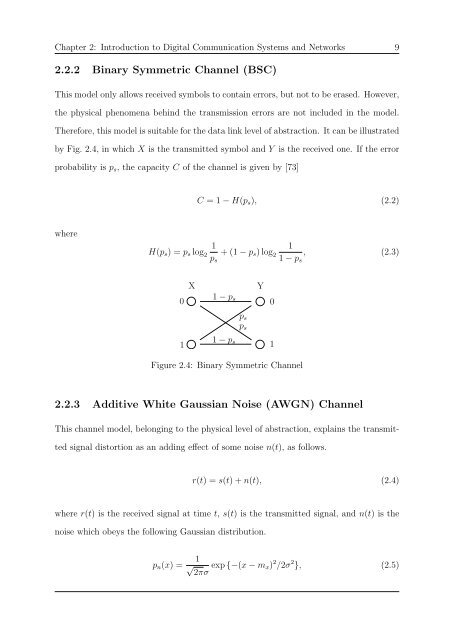Network Coding and Wireless Physical-layer ... - Jacobs University
Network Coding and Wireless Physical-layer ... - Jacobs University
Network Coding and Wireless Physical-layer ... - Jacobs University
Create successful ePaper yourself
Turn your PDF publications into a flip-book with our unique Google optimized e-Paper software.
Chapter 2: Introduction to Digital Communication Systems <strong>and</strong> <strong>Network</strong>s 9<br />
2.2.2 Binary Symmetric Channel (BSC)<br />
This model only allows received symbols to contain errors, but not to be erased. However,<br />
the physical phenomena behind the transmission errors are not included in the model.<br />
Therefore, this model is suitable for the data link level of abstraction. It can be illustrated<br />
by Fig. 2.4, in which X is the transmitted symbol <strong>and</strong> Y is the received one. If the error<br />
probability is p s , the capacity C of the channel is given by [73]<br />
C = 1 − H(p s ), (2.2)<br />
where<br />
H(p s ) = p s log 2<br />
1<br />
p s<br />
+ (1 − p s ) log 2<br />
1<br />
1 − p s<br />
, (2.3)<br />
0<br />
1<br />
X<br />
1−p s<br />
p s<br />
1−p s<br />
p s<br />
Y<br />
0<br />
1<br />
Figure 2.4: Binary Symmetric Channel<br />
2.2.3 Additive White Gaussian Noise (AWGN) Channel<br />
This channel model, belonging to the physical level of abstraction, explains the transmitted<br />
signal distortion as an adding effect of some noise n(t), as follows.<br />
r(t) = s(t) + n(t), (2.4)<br />
where r(t) is the received signal at time t, s(t) is the transmitted signal, <strong>and</strong> n(t) is the<br />
noise which obeys the following Gaussian distribution.<br />
p n (x) = 1 √<br />
2πσ<br />
exp {−(x − m x ) 2 /2σ 2 }, (2.5)

















